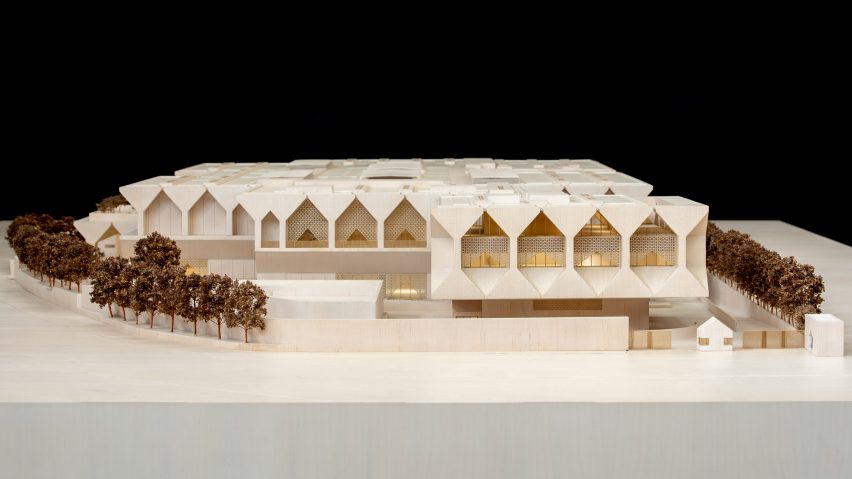The Kiran Nadar Museum of Art has unveiled plans for a major new building designed by Ghanaian-British architect David Adjaye, which is on show at the Venice Architecture Biennale.
Set to become India's largest art and culture centre, the museum is under construction on a 100,000-square-metre site in Delhi.
The design is revealed for the first time in the form of a scale model created by David Adjaye's firm, Adjaye Associates, for the Curator's Special Projects section of the biennale.
Scheduled to open in 2026, the building will facilitate the expansion of the Kiran Nadar Museum of Art (KNMA), a museum led by one of India's most prominent collectors of contemporary Indian art.
Kiran Nadar established the museum in 2010. It currently operates across two small venues, in New Delhi and Noida, and has a collection of more than 10,000 works.
The new KNMA will bring visual arts, music, dance and theatre all together under one roof. "The collection was growing and I felt we needed a stand-alone space," Nadar told Dezeen.
"We want to make it a destination," she explained. "My hope is that art and culture will feed on each other; we want a multi-dimensional institution where people from different walks of life will come and spend a day."
Adjaye Associates is working with Indian architecture firm S Ghosh & Associates on the project.
Adjaye revealed details of the design in a conversation with Glenn Lowry, director of the Museum of Modern Art (MoMA), on the opening day of the biennale.
The architect described it as "an agglomeration of pavilions that come together".
"It is a cluster of buildings that are surrounding courtyard spaces," Adjaye said. "For me, that's a response to the incredible heritage of India in terms of dealing with the climate and the richness of the culture."
Adjaye won a competition for the project back in 2019, with a design for a high-rise building.
The design had to be rethought when the museum decided to build on a different site than originally intended. This led Adjaye to develop a more low-rise building.
According to Adjaye, the core concept has remained the same throughout. He describes the current design as "a horizontal version of the vertical idea".
"A common theme in all my work is the way in which you create a path," he said.
"When we changed to a horizontal building, it no longer became about moving from the urban part to the top; it became about going through a series of courtyards and gardens. It's all about engaging with nature and with extraordinary spaces for art."
Adjaye said his inspirations for the project include the Kimbell Art Museum in Texas, designed by architect Louis Kahn, a building famous for its manipulation of natural light.
The architect also credits the late Indian architects Charles Correa and Balkrishna Doshi, who he said were "instrumental in showing me so many things in India".
This led him to add many details that reference Hindu and Muslim culture, such as the repeating triangles that feature across the facades.
"I think there are a lot of people in the west who don't understand how deep the architectural history of India is," he said. "It is one of the wonders of the world."
KNMA presents the model alongside works from the museum's collection by Indian artists Tyeb Mehta, Zarina and Nasreen Mohamedi, and a film by Amit Dutta.
They are show in the Arsenale venue at the Venice Architecture Biennale, in a section titled Mnemonic.
Exploring the relationship between memory and architecture, Mnemonic is one of eight sections that make up this year's biennale exhibition, The Laboratory of the Future, curated by Lesley Lokko.
The Venice Architecture Biennale takes place from 20 May to 26 November 2023. See Dezeen Events Guide for information about the event, plus a list of other architecture and design events taking place around the world.

